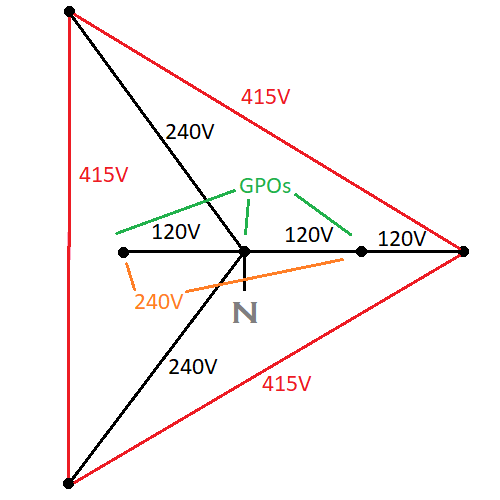wwhitney said:
haven't been following why 3 phase services came up):
Merely for higher AC charging power. A fairly rare need.
- I think 3 phase wye services can be formed with 3 separate single phase pole mount transformers.
Yes. But then one
end of each secondary is connected to neutral/ground, which means you can't supply both 120V and 240V outlets in the usual way. I suppose you could put all the 120V outlets on one winding, and have the 240V outlet connect neutral to one end. That would work, except for outlets with 4 terminals, otherwise the one labelled neutral would actually be 120V above earth, and that would presumably be a safety risk (I'm unclear on that point; live chassis radios are now rather rare). It might overload that one winding, though it could be wound with thicker copper than the other windings to compensate. One phase would take all the outlet loads plus 1/3 of the EV load, but most residences are single phase anyway, so that's no different.
- If the POCO supports it (it may not), one or two single phase transformers can be added to a 120/240V single phase service to form an open or closed 3 phase hi leg 240V delta. That won't let you balance 120V loads across all 3 phases, but you could balance 240V loads, or power 240V 3 phase delta loads.
Yes, though again the 240V loads would have non-standard potentials with respect to ground. Some would have higher than 120V from "neutral" to ground, I think. [ Edit: sigh, No. They would all be 120V with respect to ground. ]
- I think that often the same pole mount transformer can be used for 120/240V single phase service, or one leg of a 208Y/120V service.
That seems the same as your first point, assuming that there are GPOs at the site. Even specialised sites like EV charging stations would I think have at least a few GPOs for convenience, cleaning, maintenance, etc. So the same comments re non-standard potentials with respect to ground apply.
Sorry for prolonging the off-topic chat; I don't often get to think about North American power systems and their different arrangements.
GerryAZ said:
Wayne is correct, 3 single-phase pole-mount transformers could be connected to give 208Y/120-volt service.
Edit: I had confused 208Y with high leg delta. Sigh.
So this would be essentially 3 120V circuits (albeit with vastly reduced neutral conductor current), which still only gives some 11kW for 32A.

